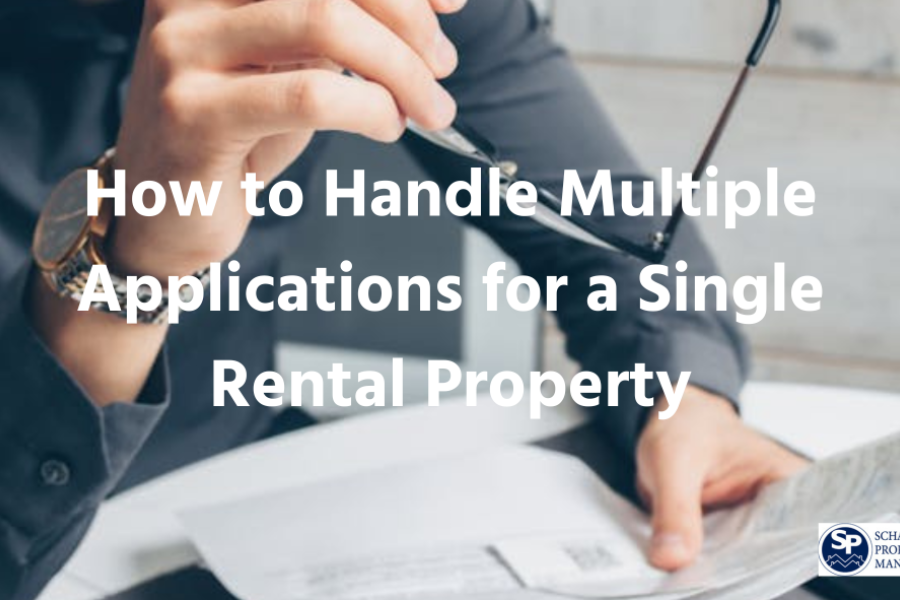
Key Takeaways
- Use Clear Screening Criteria – Apply the same standards to all applicants.
- Set a Deadline – Let applicants know when and how you'll review applications.
- Document Everything – Keep records and follow legal notice requirements.
- Communicate Promptly – Update all applicants and keep backups ready.
Have you ever listed a rental property and received several strong applications all at once? It can feel like a good problem to have, but if not handled correctly, it can also become a stressful one.
Choosing the right tenant is important, and how you manage the process can impact your legal liability, your reputation, and your peace of mind.
To help with this, Schambs Property Management has put together a straightforward guide to walk landlords through the process of handling multiple applications in a clear, legal, and efficient manner.
A Step-by-Step Guide to Managing Multiple Rental Applications
1. Define Your Screening Criteria
Before reviewing any applications, you should first create a checklist of qualifications.
This means setting clear, measurable screening criteria such as minimum income, credit score, rental history, background check results, and pet policies.
Avoid making decisions based on personal preferences or gut feelings. Instead, apply the same standards to every applicant to ensure fairness and to comply with fair housing laws. Well-defined screening guidelines help you avoid legal issues and make the decision process easier.
2. Set a Clear Application Deadline
Let applicants know exactly when the application period begins and ends. This can prevent confusion, reduce pressure to make rushed decisions, and avoid arguments from applicants who applied later in the process.
Some landlords choose to review all applications after the deadline, while others review them on a rolling basis. Either way, the process should be clearly communicated in advance.

By setting a firm deadline, you create a fair opportunity for all applicants to be considered and give yourself a reasonable timeframe to compare applications side by side.
3. Yes, You Can Choose Among Prospective Tenants
As a landlord, you have the right to choose the best qualified applicant strictly on the basis of the screening criteria you’ve established.
It is illegal to discriminate based on race, religion, national origin, gender, disability, family status, or other protected categories under the Fair Housing Act.
This means you can reject someone based on poor credit, insufficient income, or a negative rental history, but not because of personal characteristics unrelated to their qualifications as a tenant.
Keep detailed records of how each application was evaluated to protect yourself in case of future disputes.
4. Review Applications as They Arrive
If you choose to review applications as they are received, make sure you stick to your screening process and document each step.
Many landlords prefer the rolling review method because it allows them to act quickly if a well-qualified applicant applies early. However, make sure every applicant is evaluated using the same criteria in the same order.
5. Communicate Promptly with All Applicants
Keep your applicants informed throughout the process. Let them know when their application has been received, if more information is needed, and when you expect to make a decision. Clear and prompt communication helps avoid misunderstandings and shows professionalism.

Once you’ve made a decision, notify both the selected applicant and those who were not chosen.
A brief and polite message is enough, but if an application was denied due to information found in a credit or background report, you must provide an adverse action notice as required by law.
6. What to Do When You Accept a New Tenant
When you choose an applicant, move quickly to confirm their acceptance. Send them a written notice of approval, provide a copy of the lease agreement, and clearly explain the next steps such as signing the lease, paying the deposit, and setting a move-in date.
Until everything is signed and the deposit is received, continue to communicate with other qualified applicants so you’re prepared in case your chosen tenant backs out.
7. What to Do When You Deny a Rental Application
Rejecting an application should be done professionally and according to legal requirements. If the denial is based on credit, criminal background, or other third-party screening results, federal law requires you to issue an adverse action notice.
This notice must include the name and contact details of the agency that provided the report and a statement of the applicant’s right to dispute the information.
.jpg)
Avoid giving personal feedback or extra details that could lead to misinterpretation or legal issues. Be respectful and brief.
8. Keep Backup Applicants in Mind
Always have a few backup options in case your first-choice applicant withdraws or fails to meet final lease requirements. Let your top two or three runners-up know they are still being considered. This can save you valuable time and help prevent long vacancies.
Make sure to keep their application information secure and up to date, and communicate with them right away if your original tenant falls through.
9. Other Things to Keep in Mind
Handling multiple applications also means being mindful of privacy, documentation, and your responsibilities under local landlord-tenant laws. Keep all applications and communications organized and secure. Make notes of when documents were received and decisions were made.
Check with your state or local housing authority to confirm whether there are additional requirements for application processing or tenant selection.
10. Reflect and Improve Your Process
After you’ve filled the vacancy, take some time to review what went well and what could be improved. Did you communicate clearly with applicants? Was the screening process efficient? Were there any delays or mistakes?
Use each experience to improve your system. This might include updating your application form, refining your screening criteria, or automating parts of your communication process.
Bottom Line
Handling multiple rental applications requires a consistent, legal, and organized process. Start with clear screening criteria, set deadlines, communicate with all applicants, and keep thorough records.
Always make your decisions based on qualifications, not personal preferences, and follow all required legal steps when accepting or denying applicants.
Schambs Property Management helps landlords navigate every step of the tenant selection process. From setting up fair screening procedures to managing communication and compliance, we take the guesswork out of finding the right tenants.